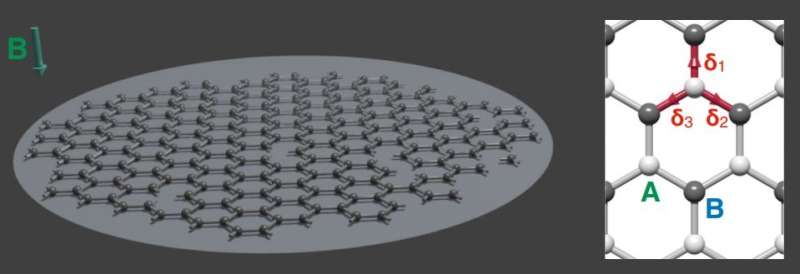July 25, 2018 feature
Holographic image of a black hole proposed in a graphene flake

Physicists have theoretically shown that, by applying a magnetic field to a small, irregularly shaped graphene flake, the flake becomes a quantum hologram of a black hole. This means that the graphene flake recreates the spatial structure and characteristic properties of a black hole, but in a much smaller, lower-dimensional system.
The physicists, Anffany Chen and coauthors from institutions in Canada, Israel, the UK, and the US, have published a paper on the graphene quantum hologram in a recent issue of Physical Review Letters.
"We show that a rather ubiquitous and well-studied material—graphene—can behave in novel and exciting ways under certain conditions," coauthor Marcel Franz, a physics professor at the University of British Columbia, told Phys.org. "Specifically, the electrons in a nanoscale-sized flake of graphene with an irregular boundary and in an applied magnetic field could realize the so-called Sachdev-Ye-Kitaev (SYK) model."
As the physicists explain, the SYK model illustrates a type of "holographic duality," in which a higher-dimensional system (here, a black hole in (1+1)-dimensional spacetime) can be represented by a lower-dimensional system (in this case, the electrons in graphene, which occupy a (0+1)-dimensional spacetime).
The type of holographic duality illustrated by the SYK model is particularly interesting because it exhibits some of the signature properties of black holes, such as non-zero residual entropy and quantum chaos propagation. It may also help answer fundamental questions about the connection between quantum mechanics and gravity.
"The SYK model is of great interest to physicists today because it is believed to contain a holographic description of a quantum black hole," Franz said. "Some of the most enigmatic mysteries in modern physics lie at the interface between Einstein's general relativity (a theory describing spacetime, gravity and black holes) and quantum mechanics (a theory describing microscopic phenomena, electrons, atoms, etc). A better understanding of the SYK model could therefore shed light on these fundamental questions."
Unlike other systems that have been proposed to demonstrate the SYK model, the new quantum phase of graphene does not require any advanced fabrication techniques and should be realizable using existing technology. The main requirements are that the graphene flake have a highly irregular boundary and a clean interior so that the electron wave functions have a random spatial structure, which provides the necessary conditions for realizing the hologram of a black hole.
"We are currently working on understanding the transport properties of the graphene flake in the SYK regime," Franz said. "More generally, we are hoping that our theoretical results will motivate experimentalists to study graphene flakes of the type required to produce the SYK physics, and we are ready to provide theoretical support to any such efforts."
More information:
Anffany Chen et al. "Quantum Holography in a Graphene Flake with an Irregular Boundary." Physical Review Letters. DOI: 10.1103/PhysRevLett.121.036403
Also at arXiv:1802.00802 [cond-mat.str-el]
Journal information: Physical Review Letters
© 2018 Phys.org



















